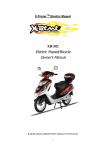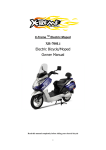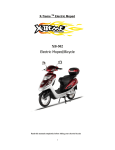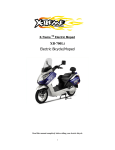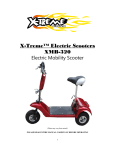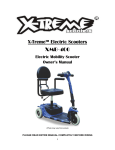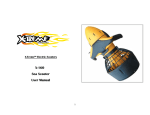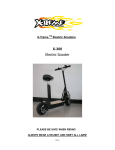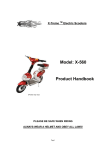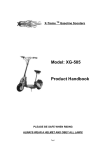Download X-Treme XB-610 Owners Manual - Discover Your Mobility Main Menu.!
Transcript
X-Treme TM Electric Moped XB-610 Electric Bicycle Owner Manual Read this manual completely before riding your electric bicycle 1 Contents Table of Contents………………………………………………………………………….. 2-3 Riding Safety ……………………………………………………………………………… 4-6 Product Features…………………………………………………………………………… 7 Package Contents………………………………………………….……………………….. 8 Installation Instructions…………………………………………….……………………… 8-12 Front Wheel & Brake………………………….……………………………………… 8 Handle Bar Installation………………………..……………………………………… 9 Trunk/Pedals/Mirror Installation……….…………………………………………….. 10 Battery Connection & Initial Charging Instructions………………………………… 11 Tire Inflation…………………………………………………………………………. 12 Product Specification…………….……………………………………………………….. 12 Operation……………………………………………………………………………………13 Riding Tip Checklist……………………….………………………………………………. 13 Battery Charging & Safety………………………………………………………………… 13-14 Basic Maintenance & Schedule………………………………..………………………….. 15-16 Other Information…………………………………………………………………………. 16 How To Instructions……………………………………………………………………….. 17-21 How To Fix Wobbly Handle Bars……………………………………………………. 17 How To Center Handle Bars…………………………………………………………. 17 How To Remove Hub Motor………………………………………………………… 17 How To Replace Controller………………………………………………………….. 17-18 How To Replace Rear Inner Tube……………………………………………………. 18 How To Replace Dash…………………………………………………………………18 How To Check Brake Safety Switch…………………………………………………. 18-19 How To Adjust Drum Brakes………………………………………………………… 18 How To Install Bearings……………………………………………………………… 18 How To Replace/Install Throttle……………………………………………………… 18-19 How To Align Front Forks……………………………………………………………. 19 How To Test Rear Wheel & Controller………………………………………………. 19 How To Check Voltage……………………………………………………………….. 19-20 2 How To Test Motor Sensors………………………………………………………….. 20-21 Troubleshooting…………………………………………………………………………… 21-28 Scooter Won’t Run, Charger Light Stays Green…………………………………….. 21 Scooter Won’t Run, Charger Light Stays Red & Green……………………………… 21 Is It My Throttle Or My Controller?............................................................................ 21-22 Throttle Voltage Test…………………………………………………………………. 22 Intermitted Power Loss………………………………………………………………. 22-23 No Power…………………………………………………………………………….. 24-25 After Fully Charging, Powers Only For Short Distance Use………………………… 25 Scooter On, Won’t Run………………………………………………………………. 26 Scooter Will Not Move……………………………………………………………….. 26 Charger……………………………………………………………………………….. 26-27 Hub Motor Tests……………………………………………………………………… 27-28 Diagrams…………………………………………………………………………………… 29-30 Wiring Diagram……………………………………………………………………… 29 Battery Wiring Diagram……………………………………………………………… 30 Support…………………………………………………………………………………….. 31 DO NOT RETURN TO STORE! Do not use this vehicle for the first time until you have inflated the tires to the correct PSI and completely charged the battery. Failure to follow these instructions may damage your vehicle and void your warranty. CALL TOLL FREE OR GO ONLINE 1-253-777-0690 www.x-tremescooters.com/support/ For General Information or Parts Visit www.x-tremescooters.com RIDING 3 RIDING SAFETY Like any sport, biking carries the risk of injury and damage. By choosing to ride the electric bicycle, you assume all responsibility for these risks. Thus, you need to know and practice the rules of safe and responsible riding. YOUR INSURANCE POLICIES MAY NOT PROVIDE COVERAGE FOR ACCIDENTS INVOLVING THE USE OF THIS ELECTRIC BICYCLE. TO DETERMINE IF COVERAGE IS PROVIDED YOU SHOULD CONTACT YOUR INSURANCE COMPANY OR AGENT. Safety Basics: Do’s and Don’ts The Do’s o Always conduct a Safety Check before you ride your electric bicycle. Be thoroughly familiar with the controls of your electric bicycle. o Always wear an approved helmet when riding your electric bicycle. Follow the helmet manufacturer’s instructions for fit, use and care of your helmet. o Always keep body parts and other objects away from the spinning wheels of your electric bicycle. o Always wear shoes that will stay on your feet and will stay on the floorboard. o Wear bright, visible clothing that is not so loose that it can catch on moving parts of the electric bicycle or objects at the side of the road or trail. o Think about your speed, and keep your speed consistent with safe operating conditions. The Don’ts o Never ride with headphones. They mask traffic sounds, distract you from concentrating on your surroundings, and their wires can tangle in the moving parts of the electric bicycle, causing you to lose control. Never carry a passenger. The maximum carrying capacity is 300 lbs. o Never ride barefoot or wearing sandals. o Don’t jump with your electric bicycle. It puts great stress on everything from frame and forks to drive train. Riders who insist on jumping their electric bicycle risk serious damage to their electric bicycle as well as to themselves. o Never carry anything which obstructs your vision or your complete control of the electric bicycle or which could become entangled in the moving parts of the electric bicycle. o Never hitch a ride by holding on to another vehicle. 4 o Never ride your electric bicycle while under the influence of alcohol or other drugs. o If possible, avoid riding in bad weather, when visibility is obscured, at dusk or in the dark, or when you are very tired. Each of these conditions increases the risk of accident. o Never allow children to ride. Never allow others to ride without reading and understanding these instructions. Operating Reminders and Suggestions o Review all instructions carefully before riding the electric bicycle. o Follow all rules and regulations in your area for operating a motorized bicycle. Obey the same road laws as all other road vehicles, including yielding the right-of-way to pedestrians, and stopping at red lights and stop signs. o Ride predictably and in a straight line. Never ride against traffic. o Ride defensively. To other road users, you may be hard to see. o Concentrate on the path ahead. Avoid potholes, gravel, dirt, wet road, oil, curbs, speed bumps, drain grates and other obstacles. o Be alert for unexpected events, such as opening car doors or cars backing out of concealed driveways. o Be extra careful at intersections and when preparing to pass other vehicles. o Don't carry packages or passengers that will interfere with your visibility or control of the bike. Don't use items that may restrict your hearing. o Maintain a comfortable stopping distance from all other riders, vehicles and objects. Safe braking distance and forces are subject to the prevailing weather and road conditions. Wet Weather Riding Wet weather impairs traction, braking and visibility, both for the rider and for other vehicles sharing the road. The risk of accident is dramatically increased in wet conditions. In wet weather you need to take extra care. In wet conditions, the stopping power of your brakes (as well as the brakes of other vehicles sharing the road) is dramatically reduced. This makes it harder to control speed and easier to lose control. To make sure that you can slow down and stop safely in wet conditions, apply your brakes earlier and more gradually than you would under normal, dry conditions. Decrease your riding speed, avoid sudden braking, and take corners with additional caution. Keep in mind that there is a direct, but inverse, relationship between speed and controllability. Be more visible on the road. Wear reflective clothing and use safety lights. Potholes and slippery surfaces such as lane markings and train tracks all become more hazardous when wet. Night Riding A rider is very difficult for motorists to see at dusk, at night, or at other times of poor visibility. If you must ride under these conditions, check and be sure you comply with all local laws about 5 night riding; follow the Rules of the Road, and take the following precautions: Make sure that your electric bicycle is equipped with correctly positioned and securely mounted reflectors. Make sure your clothing or cargo does not obstruct a reflector or light. Wear light colored, reflective clothing and accessories, any reflective device or light source that moves will help you get the attention of approaching motorists, pedestrians and other traffic. Ride slowly. Avoid hazards, such as potholes and curbs. Avoid areas of heavy traffic, dark areas, and roads with higher speed than limited. If possible, ride on routes already familiar to you. Ride at night only if necessary. Slow down and use familiar roads with street lighting, if possible. Other Important Reminders The battery does NOT require deep discharging. If your electric bicycle is put into storage, re-charge its battery at least once every 90 days. Do not store your electric bicycle in direct sunlight for an extended time. Store your electric bicycle in a dry place. Exposing your electric bicycle to rain, snow, or other precipitation may result in damage. 6 Product features 7 Package Contents: Electric Bicycle 48V 20AH Charger Left & Right Mirrors Front Tire Front Fender Left & Right Foot Pedals Ignition Keys Foot Pad Trunk User Manual Preparation for Assembly A. Remove the cardboard carton exposing the steel frame crate. B. Remove the bolts holding the top and side center post on the steel frame. Remove the top & center post and set aside. See page 9 number 2-1 C. Bend the front and back frame sides down to the ground so they are out of the way. D. To assist with assembling the front wheel remove the wire ties holding the front axle (leave the rear axle wire ties connected for stability). E. Remove all protective packaging. F. Remove Axle from front fork & shipping crate and set aside, do not discard. G. Find a solid square object about 10” to 12” high and with assistance raise the front of the bike and place it under the floor board battery compartment. This will allow for easier front wheel installation. H. Remove bolt from handle bar stem and place handle bars onto steering shaft. This will give extra brake cable length for installing the brake drum on the wheel and fork. I. Remove the screw holding the front brake assembly on the fork. Install front wheel and brakes per instructions below – Page 8 8 1.) INSTALLATION OF FRONT WHEEL AND BRAKE. 1. Insert brake hub onto wheel as shown above. 2. Slide wheel into front forks being sure to align brake hub bracket with right side fork. See image below. (When sitting on bike, front brake is on riders left side of front wheel) 3. Slide axle thru left fork, then spacer before inserting it into the left side of front wheel. 4. Secure with nut on right side (brake side) and tighten securely 5. With front wheel installed proceed to mount the front fender. The fourth screw for the fender is in the plastic bag with the trunk bolts. 9 2.) HANDLEBAR INSTALLATION 1. Locate and remove the handlebar bolt, washer & nut as shown. For access to the nut on the back side, turn the handlebars fully to the right. 2. Slide handlebars over post in the correct position, then insert the bolt & concave washer into the front (speedometer side) of the handlebars and secure with nut on the back (riders side). Concave washer should be partially inserted into the handlebar and make contact with internal post to be tightened properly and securely. 3. Using two 14mm wrenches place one on the front bolt from the top and the second on the nut by reaching up from the bottom under the fairing. Carefully tighten checking to confirm concave washer is placed correctly in the slot. Connecting Instrument Panel The instrument panel is located in the seat storage compartment, use key to open. 1) Six pin connector on instrument panel connects to six pin connector on wire harness on top of the handlebars. 2) Two pin connector with one Black wire on instrument panel connects to two pin connector with one Grey wire on wire harness. (Some unit may have one extra connector on the instrument panel. If it has a two pin female connector with Red and Purple wires it is left empty and not used.) ** Before mounting the instrument cluster confirm all wire connections are firmly together and connector covers placed over terminals securely. 10 3-5.) TRUNK/PEDALS & MIRROR INSTALLATION 3. Attach trunk to back cargo rack using the four (4) enclosed bolts/nuts & washers. Secure to rack with the washers & nuts on the underside. 4. Attach left & right foot pedals according to correct side by lining up pedal with bearing on pedal shaft and snap into place. 5. Mirrors are located inside the trunk. Screw left & right mirrors into place and adjust to appropriate riding position. ***Mirrors install with an upward angle; Do not try to force horizontal. 11 6.) BATTERY CONNECTION & INITIAL CHARGING 1. Remove battery pack and locate plug. 2. Plug battery wire into battery pack and reinstall battery pack under foot plate. 3. IMPORTANT: Completely charge battery for a maximum of 8 hours before use. DO NOT CHARGE FOR MORE THAN 8 HOURS AS THIS CAN DAMAGE BATTERIES. Main Fuse Main fuse is located inside battery case under floor mat. 7.) TIRE INFLATION Finally, inflate both tires to the minimum recommended tire pressure depending on the number of riders that will be using the bike. Recommended tire pressure is between 35 – 45 PSI. We do not recommend filling tire beyond 45 psi. * Be sure to check all nuts, screws and terminals on the bike for tightness and proper fit before riding. 12 Product Specifications 1. Wire diagram 2. Specifications Battery Voltage 48Volt Dc,20Ah Motor Wattage 600W Wheel Size 16 inch Top Speed 35km/h Charging Time 6-8h Distance of full charge 50km Battery charging cycles <300 times Max rider weight 300lbs Two rider Yes Left and Right Indicators Yes Rear View mirrors Yes 13 Operation Your new Electric Bicycle/scooter is a revolutionary new transport product using a sealed lead acid batteries and a super high efficiency electric hub motor designed to ASSIST in the propulsion of you and your bicycle. It is important to note the following riding guidelines to ensure you get the best possible experience from your electric bicycle. Riding tip checklist A) When starting off from a stand still pedal the bicycle up to speed then engage throttle for best results. B) On inclines pedaling will be required to maintain momentum. C) Remember performance of the bike is directly related to weight of the rider and any baggage/load together with the charge in the batteries. D) Ensure batteries are fully charged prior to riding. E) Never let the batteries fully discharge. This will reduce battery and bike performance. F) If your bike is equipped with lights we recommend you ride with them switched on at all times to increase visibility for you and other road users. Battery Charging and & Battery Safety Charging figure 1-4 Charging (see figure 1-4) A. B C. Ensure bike is turned off and key is removed. First connect to the battery charger to the charging socket located below the front of the seat. (Optionally, you can also remove the battery pack and charge outside of the bike if preferred) Then insert the power plug on the battery charger into 110v power outlet. 14 D. While charging the light on the battery charger will illuminate Red. E. When fully charged the light will illuminate Green. F. NEVER CHARGE FOR OVER 8 HOURS. DAMAGE MAY OCCUR TO BATTERY G. Always charge the bike in a well ventilated area protected from bad weather & wet conditions. NEVER CHARGE THE BIKE INSIDE YOUR HOME ONLY CONNECT THE BATTERY CHARGER LEAD TO THE BIKE CHARGER INLET. NEVER CONNECT ANY OTHER POWER SOURCE TO THE BIKE CHARGER INLET. Battery Charging Safety Notes 1) While charging the Battery, keep the key switch OFF. 2) Verify that you are using the correct charger for your vehicle, and that the charger input power is compatible the “house current” in your area. 3) Keep the charger and battery away from water to prevent electrical shock and shorting. The charger is intended for indoor use only. 4) Read the charger label to learn about the charger indicator lights, and their meanings. 5) Generally, a short drive will require a short time to re-charge, and a long ride will require a longer time. A complete (90%) discharge may require 6 hours to recharge. To prevent electrolysis (battery fluid loss by hydrogen generation,) do not charge for longer than eight hours. WARNING Do not place the battery near heat or fire. Do not expose the chargers to water. Maintenance ----Basic 1. Your bike comes with a 30amp fuse, pre-installed at the factory and is located inside the battery box. 2. Clean Chain Regularly. 3. Ensure Tires are inflated to 35-45 PSI. 4. Adjust Brake tension via adjusting screws located at Brake lever or on Brake control lever. 5. Ensure regular servicing according to the schedule. 6. Do not attempt to change any electronic components except changing light bulbs. 7. DO not attempt to modify, open or perform maintenance on the Hub Motor. 8. Any attempt to modify electrical components will void the warranty unless specifically requested by a X-treme Scooters representative. 15 Maintenance ----Schedule Service Interval Daily Monthly Every Months Inspect Tires for wear and condition and inflation Yes Yes Yes Yes Check and adjust Brake Yes Yes Yes Yes Check operation of all lighting and horn devices. Replace globes if necessary Yes Yes Yes Yes Yes Yes Test Battery Capacity 6 Yearly Replace Wheel Baring Grease Yes Full Brake Pad Change over Yes Check condition and torque settings of wheel nuts and suspension forks Yes Yes Other Helpful Instructions Pedals 1. Use a pedal wrench of 16mm spanner to tighten pedals. 2. Check and tighten pedal crank bolts with 14mm socket. Tires 1. Inflate tire using a pump to 35-45psi. Remember lower tire pressures will negatively impact performance by causing too much resistance, but over inflating may cause the tube to burst. Chain 1. Give the train a light drop of bicycle chain oil or sewing oil. Do not use RP7 type lubricants. 16 How To Fix Wobbly Handle Bars 1. 2. 3. 4. Remove the instrument panel by taking out the six (6) screws from the bottom and disconnecting the wire connectors Look at the bolt that clamps the handle bars to the steering stem: is the gold spacer seated correctly? Tighten the bolt by using two 14mm wrenches – one from above on the front of the bolt and the other by reaching up under the wheel well to hold the nut in place while the front one tightens the bold snuggly. Check handle bars for secure fit. If still wobbly remove bolt, reset handle bars and tighten. Having the bolt securely tight will eliminate the handle bars from wobbling. How To Center Handle Bars 1. 2. 3. 4. 5. First remove the dash. You should not have to remove it completely, but at least split it so you may access the space in the center of the handle bar. In the center of the handle bar you will see the head of a small bolt. Loosen this bolt up slightly until the handle bars can move to the correct position. When the bars are aligned properly tighten the bolt. Reassemble the dash pieces. How To Remove Hub Motor 1. Remove the two nuts on each side of the motor. 2. Remove brake adjustment nut and remove brake cable from brake hub. 3. Remove brake hub lock nut where it attaches to frame. 4. Remove axle lock plate by removing the #10 bolt on each side. 5. Follow the motor wires up under the rear fender, it will connect to quick disconnects and unplug the cables. 6. Follow the chain up to the pedal sprocket and move the chain off of sprocket. Use the pedals to turn until the chain is totally off of the sprocket. Then remove the sprocket off of wheel sprocket. 7. Remove wheel motor from scooter. How To Replace Controller 1. 2. Remove the Battery Pack from the scooter and set aside until new controller is installed. Open the seat and remove the four (4) seat barrel screws, two (2) near the Latch and two (2) in Front. 17 3. 4. 5. 6. 7. 8. 9. 10. Remove entire Seat and Seat Barrel from scooter. Unscrew your old controller from the frame - Leave wires connected. Mount the New Controller in its location. Transfer One Connector at a time from the old controller to the new controller. Re-install Battery. With drive wheel not touching any surface Test Run and confirm all functions are working. Re-assemble and test ride. This is also a good time to perform the recommended maintenance as listed in the Handbook. How To Replace Rear Inner Tube 1. 2. 3. 4. 5. Remove the seat and seat barrel. 4 screws need to be removed, 2 by the hinge and 2 down inside and remove from scooter. Follow the wire coming out of side of motor and cut the tie straps leading up the controller. Remove the wheel nuts and remove the brake adjustment nut and remove the wheel. Let all air out of tire and use either a tire wrench or couple dull screw drivers to remove tire bead from one side of rim to remove and install the tube. Install in reverse order make sure that the motor nuts are on extremely tight, use a 2 1/2' crescent wrench to tighten them. How To Replace Dash 1. 2. 3. 4. 5. 6. 7. 8. 9. First remove the four screws on the black gooseneck cover below the handle bars. Then you will be able to remove the headlight faring. It will slide down and forward. Unhook the wires to the headlight and set the headlight faring aside. Then you remove 5 screws on the back of the handle bars. There is 1 screw on the front of the handle bars, also remove that. Remove the mirrors from the scooter by turning counterclockwise. Now the handle bar faring is ready to be removed, Start on the left side by where you removed the mirror. Gently pull the front and back of the handle bar fairing apart. It should snap apart fairly easily. Work your way across until the top is completely apart. Remove and replace. Reverse the order to reassemble. How To Check Brake Safety Switch 1. First remove front fairing and check the throttle connector and brake connectors for loose 18 2. 3. connection. Tug on each wire to make sure its locked into the connector. Open seat and remove the 4 bolts that attaches the seat barrel to the scooter. 2 bolts on each side of the seat latch and the other 2 are in down in bottom front of seat barrel. Lift off the seat and seat barrel as one piece. Location of brake safety connection: You should see a box with several wires coming out of it. You will also see these wires go into quick disconnects and locate a 4 wire plug. There will only be one and on the controller side of the connector the wire colors are: Yellow, Red, Black and Green. On the opposite side the colors are Blue, Green with Yellow stripe, Gray and Green. Unplug the connector and locate the Blue wire, on the opposite side of the wire goes into the male connector we will need to unlock the gold pin to remove the wire from the controller. How To Adjust Drum Brakes 1. 2. 3. 4. 5. Loosen the brake handle adjustment on handlebars to fully outward. Locate the brake cable adjustment screw and screw this in all the way. Follow your brake cable to the brake caliper. There will be a small nut holding the metal cable to the caliper arm. Loosen this nut, move the brake arm while holding the cable tight until the brake just starts to drag when the tire is turned off the ground. Tighten the lock nut back down onto the cable. Next fine tune the adjustment by screwing the cable tension screw outward to pull on brake line until proper braking is achieved. Lock this position down by tightening the nuts. Avoid adjusting brakes on handlebars because there is a safety switch built into the handles to kill motor while using the brakes. How To Install Bearings 1. 2. 3. 4. Remove the rear wheel. Remove the old bearing. To do this, you will need to insert something, like a screw driver, from the opposite side and simply push it out. Put the new bearings in. You will want to use something like a rubber mallet so you do not crack the bearings. Set the wheel on a flat, absorbent surface, like a work bench. Tap the bearing into the wheel evenly. Re-install the tire and test ride. How To Replace/Install Throttle 1. Remove six Phillips head screws from handlebar cover. 19 2. 3. 4. Unplug six pin and one pin connectors from instrument panel. Follow wire from throttle housing to white connector and unplug, (should be 3-pin connector with black, red and white wires). Loosen small allen head bolt from throttle housing and slide throttle from handlebar. How To Align Front Forks 1. 2. 3. Remove the dash on the backside. Find the 12mm bolt in the center of the handlebars and loosen it. Take a hammer and hit this bolt. Stand with the front tire between your legs. Hold the tire with your legs and turn the handlebars into position. Tighten the 12mm bolt and reassemble the dash. How To Test Rear Wheel & Controller Place scooter up on center kickstand, turn scooter ignition in the "ON" position. Spin rear wheel by hand and check to see if it falls in one of the following conditions: A.) Wheel spins with slight resistance – Controller could need replaced B.) Wheel spins hard like brake engaged – Controller and motor could need replaced C.) Wheel spins Jerky – Controller and motor could need replaced How To Check Voltage Tools Needed: Multi-meter to read VDC First be sure the battery connector from the scooter is firmly attached to the battery case. Leave all connectors connected when measuring the voltage by sliding your meter probes into where the wires go on the backside of the connectors. Battery Power - 12.65vdc per battery min = +50vdc to turn on the controller. 1. Across the large Red & Black wires coming out of the controller is main power leads. Should have +50vdc here. Throttle measurement: Leave connector connected while measuring. 1. Locate the throttle connector on the controller, it will be a red connector with 3 wires coming out of it of RED, BLACK & GREEN. Put you Black meter probe in on the black wire. Insert Red probe in on the red wire and turn the scooter in the ON position. These wires are the 5v 20 supply to the throttle, and should be within this range ( 4.9 - 5.5) Now remove the red probe from the Red wire and put it on the Green wire and need 2 recorded readings one @ no throttle and other @ 100% throttle. Should be about .2vdc @ 0 Throttle and 4.9vdc @ 100% Throttle. 2. Ignition Check: Place Black meter probe on main BLACK battery wire on the controller. Locate the 2 wire connector with Orange and Blue wire from controller. Insert Red meter probe on Orange wire and should have +50vdc. Insert Red meter probe on the Blue wire and should only have +50vdc when the ignition key switch is in the ON position. 3. DC/DC controller check. This is the smaller silver box under the headlight assembly and has 3 wires coming out of it. Red & Black wire should have 48vdc with the key on, and Yellow and Black should have 12vdc before and after the Glass Fuse. The DC/DC Controller powers accessories like the lights, horn etc. How To Test Motor Sensors Sort out the motor's wiring. There is eight wires total, or leads, running from the motor to the controller. Three larger wires power the motor and are larger (16 AWG): Green, Blue, and Yellow. Two wires power the sensors and are smaller: Red and Black. And three wires connect the sensors to the controller: Green, Blue, and Yellow. All 5 small wires are connected to one white quick disconnect. For this project, we are concerned only with the smaller wires of Green, Yellow and Blue. Now, there are two methods used to determine a bad connection or which of the three sensors have failed. Both require the motor to be fully assembled. The first is to simply run the motor while one sensor lead is disconnected, “refer to section-A below on how to do this”, then again for the second lead, and a third time for the last lead. If one sensor is dead (and that's your only problem), you'll see that disconnecting one or the other of the good sensors prevents the motor from turning altogether, while disconnecting the bad one has no effect at all--it still sputters. If that didn't work, try this second method. It is more complex, but useful to identify a bad controller vs. the motor, and more nuanced issues or problems stemming from multiple failures. Remove the 3 small wires from the 5 wire connector leaving the red and black wire attached. While the motor is connected to the controller, powered, and at rest--or, alternatively, powered 21 with +5 volts from a workbench power supply--set up a multi-meter to monitor the sensor's output on one of the 3 wires. Connect the Black Voltmeter Lead to the small black wire by inserting the probe in where the wire goes into the connector. Attach the Red Voltmeter to one of the 3 wires to be tested. IMPORTANT: DO NOT let any of the small wires touch each other or will blow the sensor. Turn the motor by hand very slowly while watch the voltmeter. It should pulse to 5vdc when active and 0vdc when not. Repeat this step for other 2 wires. If all three wires Green, Blue and Yellow pulses 5vdc then the motor is good and controller is bad. Section-A: Do not have scooter powered up. Locate the white quick 5 wire connecter leading from the controller to the motor and unplug connector. With a small ice pick or large needle inserted to unlock the lock tab one of the good pins. And pull the wire out of the controller and reconnect the connector. Tape off the gold pin so you can protect it. Return to above instructions above. Troubleshooting: Scooter Won’t Run, Charger Light Stays Green When you plug your charger into your scooter and the wall outlet the charger light stays green. This is telling me that somewhere between charger socket, controller, fuse holder and batteries you have an open circuit. Please remove the floor plate and check the wires in this area. You may find a wire that is not connected, a connector that is not pushed together properly or a fuse holder that is not letting the fuse connect properly. Troubleshooting: Scooter Won’t Run, Charger Light Stays Red & Green When you plug your charger into your scooter and the wall outlet the charger light stays green. This is telling me that somewhere between the batteries, fuse, and charger socket you have an open circuit. Please remove the floor plate and check the wires in this area. You may find a wire that is not connected, a connector that is not pushed together properly or a fuse holder that is not letting the fuse connect properly. Troubleshooting: Is It My Throttle Or My Controller? (These tests require a digital VOM) Most E-scooter throttles use 'Hall-effect' devices, not potentiometers (rheostats). A Hall-effect device is a chip that responds to a movable magnet. If you have a digital VOM (I would not use an 22 analog resistance meter of any kind, as it could damage the chip if it's a Hall-effect chip), you can test whether it's a potentiometer or not. If it is, you should get 5K ohms across red and black, and of course, 0-5K from red or black to the third wire (usually green or yellow). If it isn't, you'll get readings in the megohms in one direction and no connection in the other in some cases. A better test if you have a digital VOM, is to push the probes into the back of the throttle connector at the controller while it is connected. Turn the scooter on, and operate the throttle. You should get near zero to near 4 or 5 volts between the black and third wire (green or yellow). These voltages work for most scooters, but not all. Some throttles use 0-24 volts, and some use a negative voltage (the throttle 'sinks' current). You should also check the brake inhibit switch (there should be a wire cable coming from your brake handle), to see if it is making and breaking continuity. The brake inhibit switch turns the throttle off when you put the brakes on. It functions like a 'kill switch' should anything go wrong. You should also test the key switch in the same way. You can test the motor by jumping from the batteries to the motor, but be aware that it will make a large spark, or you can test the voltage at the motor connector while turning the rear wheel backwards. The motor should generate a small negative voltage that varies with the speed it is turning. A smell test is also conclusive proof that you have a damaged controller or motor. If you can get your nose close to one or the other and it smells like badly burnt broccoli, it's burnt out. Of course it could also be burnt out and not smell, but if it smells it's burnt out. Troubleshooting: Throttle Voltage Test Follow throttle wires until you find its white connector. You will be testing the “Red”, “Green”, and “Black” wires. Set your meter to test DC volts. Block rear wheel off the ground so scooter will not take off. Turn the scooter on. Place the red meter test lead on the “Red” wire and the black meter lead on the “Black” wire. The meter should measure +5 volts. Now place the meter red lead on the “Green” wire. With out turning the throttle you should read around +0.8 volts. Now turn the throttle wide open. You should now read around +4 volts. If everything else powers up on the scooter and you do not have +5 volts between the “Red” and “Black” wire the controller is bad. If you did not get the +.8 to +4 volts then the throttle is bad. Troubleshooting: Intermitted Power Loss While doing each of the steps you are to go and test drive the scooter to make it cutout like it was doing. You will need a voltmeter for electrical readings and will also require a power cord that is 23 used on a computer which has the same type of plug that will plug into the charger port, with a wire length of 2' and cut wire and discard the rest. What we are going to do is attach the voltmeter leads to this computer wire and plug into the socket to watch actual voltage while riding and mounting the voltmeter is a spot and secure it so it doesn't move but be able to watch it while on test runs. I have provided a drawing of this called voltmeter connection.jpg above. 1. First pull up battery pack and pull the main power cord out of socket on battery pack to kill all power. 2. Unplug the Large Red and Orange 2 wire connector on controller. This connection is for the Ignition switch test, on the side that has the Red and white wire by looking down inside you will see 2 silver pins and there is a little tab that you push towards the pin and the wire will come out of the connector. Take a piece of wire about the same dia. as the orange wire approximately 4" long and strip the insulation off each end about 3/4" long. Take one end of the jumper wire and wrap around the pin where the wire is crimped on to. Then the other end of jumper to the white wire and reinsert it back into the white connector. You may need to pull out the little lock tab so it will lock into place. Reattach the connector back onto the controller, as shown in my drawing above. Plug your cord into the charger socket for the voltmeter, just set the seat and seat barrel in the scooter without bolting it. When ready plug the main battery cord in bottom of battery and turn your voltmeter on. The scooter will come as soon as you plug it in and may spark a little this normal. Go for test ride. If you get same results of still kicking out, just unplug main power cord and plug in to turn it back on. Troubleshooting: No Power In this situation we will assume that the battery has been charged or allowed to stand for several hours (a battery will normally self-charge up to a point and make the scooter power up for a fair distance). There are generally two main suspects: 1. First suspect is a loose or broken connection. Take the top or deck off to see the wiring and inspect it for any loose or broken connections on the battery, switch, controller, etc. 2. Second possibility is the controller box has failed. Since the controller is the heart of the system it can fail in many ways to prevent current from being supplied to the motor. 3. Other less likely suspects can be: A battery that is completely open, supplying no current and possible even testing as having no voltage. It can be very briefly shorted with a wire to see if an arc is produced, revealing current is present. See Below for more advice on batteries. It is also possible to have a bad brake lever or throttle since both have wiring and switches or 24 variable controls. The brake lever has a power cut-off switch. The throttle variably controls the speed of the scooter. The scooter On/Off switch can be defective. Without a good switch the scooter has no power, but the test of this is the power light. Does the power light come on when the switch is activated to the On position? Troubleshooting: After Fully Charging, Powers Only For Short Distance Use 1. Suspect the battery charger or the battery as the primary cause of short distance riding after a lengthy or full charge. If your battery charger does not have charging indicator lights then you may not be charging the battery at all if the charger is defective. 2. The battery may be self-charging to only about 60% on its own. If the battery is getting old then it may not be able to hold a full charge and the battery will need replacement. When suspected you can very briefly arc across the battery terminals with an insulated wire to see if it produces a nice arc. . It is also possible to test some individual battery 12 volt cells using 12 volt motors or lights that will show you the available current capability. Is the 12 volt light dim on a charged battery? Does the 12 volt motor run slowly when connected to the cell? Similar type tests can be performed using a 24 volt battery cell, too. WARNING! Batteries contain acid that can explode, or the vapors ignite from an arc. Batteries produce current and voltage that can burn you when a shorted circuit occurs. Be absolutely sure you know what you are doing before trying any tests to eliminate a component from consideration of being defective!!! 3. You can take the battery to a shop capable of testing the battery under a loaded condition. Fully charge the battery and carefully remove it. Let a technician determine the condition of the battery for you. 4. We recommend a high quality Battery Charger as sold on our scooter parts page. You can purchase by visiting our website at http://www.x-tremescooters.com/electric_bicycles/xb502/parts.html or contacting our Parts Department at (253) 777-0690 or by email at [email protected]. 25 Troubleshooting: Scooter On, Won’t Run A) If the scooter is moving when you turn the key to the “on” position without turning the throttle you will need to replace the throttle or control box. B) If scooter takes off without turning the key to “on” – you need to replace the control box. Troubleshooting: Scooter Will Not Move Scooter not moving and Lights do not work using battery, but lights do work when you plug the charger into the side of the scooter and also plug the charger into the wall-Scooter will not move at all and all lights do not work (lights do work when you plug the charger into wall): A) No fuse in fuse assembly= add one of the fuses includes with the scooters B) Bad Fuse= unscrew the cap only on the fuse holder. Remove the fuse and make sure that the fuse is not blown (a good fuse will have a solid wire from one end to the other, a bad fuse=the wire inside is broken) C) Bad fuse holder = fuse assembly may be cracked or have a bad connection within it. D) Bad control box E) Possibly bad battery, although this is rare. F) Wires behind fuse assembly have come off due to improper replacement of fuses or loose wire connections to the battery. This is always due to the customer rotating the whole fuse assembly (when changing fuses) and twisting the 2 wires that are in the back of the fuse holder. You must open up scooter and reattach these wires to back of fuse assembly or to battery and control box. If this is the problem the lights WILL work when you have the charger plugged in. Troubleshooting: Charger The charger is a handy tester to check the wiring connections on the battery pack all the way thru the fuse holder into the controller. Some chargers have a single light and some have 2 lights on them. When plugged into the wall you will either have a GREEN light or a GREEN/RED light. Check with the supplied manual for light status conditions. Then when you plug into the scooter the charger should change state indicating batteries found and charge mode started and the lights 26 should change to RED or RED/RED. If you plug the charger into the scooter and no change appears, this means that you have an open circuit which could be a fuse not installed or power plug not plugged into bottom of battery pack or a bad connection. All Chargers should change state even for a few minutes if batteries are fully charged. When the batteries are done charging the lights will go back to the state of GREEN or GREEN/RED means done charging. Troubleshooting: Hub Motor Tests 1. With any one of the three sensors disconnected the moped will run very jerky. It may stop but will start again if the throttle is release and then turn. 2. If two or more sensors are disconnected the motor will not start. 3. If two of the sensor leads are swapped around the motor will try to run but hardly moves. Controller is lost as to motor position. 4. If any of the motor leads are disconnected the motor will not run. 4. If the throttle is turned all the way open and the wheel is not allowed to turn the controller will shut off power within a few seconds. The throttle must be released to reset. 5. When the throttle is held wide open and the scooter is only allow to barely moving the controller will continue to supply full power and the wires will get very hot. (wires may melt if this is done for very long) Sensor Test: Use a digital voltmeter set to read ohms for these test. Disconnect all motor wires from the controller. The red lead of the voltmeter must be positive when using the ohm scale. Place the black meter lead on the black sensor lead for the next four tests. If the sensors are good you should get around these readings. There should not be a great amount of difference. 1. Place the red meter lead on the red sensor wire. 2. Place the red meter lead on the yellow sensor wire. 3. Place the red meter lead on the green sensor wire. 4. Place the red meter lead on the blue sensor wire. (7-20meg ohms) (Infinite) (Infinite) (Infinite) Place the red meter lead on the black sensor lead for the next three tests. 5. Place the black meter lead on the yellow sensor wire. (Around 4 meg.) 6. Place the black meter lead on the green sensor wire. (Around 4 meg.) 7. Place the black meter lead on the blue sensor wire. (Around 4 meg.) Test all sensor leads from lead to lead. All readings should be infinite. Use a digital voltmeter set to read DC volts for these test. Motor wires must be connected to the controller for these tests. Moped’s power switch must be on during this test. 1. Test between the red and black sensor leads. (5 volts) If you do not have +5 volts check the sensor connector. Make sure it is pushed together all the way. Check for broken or shorted wiring. The controller may have failed. 27 2. Place the negative lead of the meter into the sensor connector where the black wire is located. Place the positive meter lead into the sensor connector where the green wire is located. Slow rotate the tire. The meter should alternate between 5 volts and 0 volts if the sensor is good. Test the other two sensor wires the same way. If the voltage reads 0 or 5 volts and does not change check the sensor connector again. Causes for this may be a broken wire, or the Hall Effect sensor may have failed. If all three sensor’s read 5 volts with no change the ground wire may be broken. If all three sensor’s read 0volts with no change the positive wire may be broken. Motor Winding Test: Test all motor leads from lead to lead. All readings should be .6-.7 ohms. Controller Test: Disconnect all the motor wires from the controller to run these test. Set the volt-meter to read ohms. If your meter does not auto-range set meter to 20K ohms. Check between the red and black power wires. Meter should not show low resistance. Meters that will auto-range will go up to around 4 meg. after the capacitor has charged. Place the negative lead of the voltmeter on the black controller wire that would go to the battery negative. Place the red lead on one of the controller’s leads going to the motor. Controller motor leads will be the yellow, blue, and green leads that are not in the white connector. You should get close readings as you switch between the leads Place the red lead of the voltmeter on the red lead of the controller wire that would go to the battery positive. Place the black meter lead on one of the controller’s leads going to the motor. You should get close readings as you switch between the leads. If you get a lot of difference between readings of the motor leads the controller is be bad. Common Causes To Complaints: Any customer complaints of jerky motor or motor not running have the customer check the sensor and motor connections at the controller and at the connectors at the rear of the moped. If this doesn’t help go to steps one or two below. 1. If the customer complains that the moped is stuttering or jerking and moving slowly the most likely cause is that a motor sensor has failed and the motor will need to be replaced. 2. If the customer complains the moped shuts off during hard acceleration then starts again if the throttle is released and then turned gently. The batteries either need to be charged or one or more of the batteries are bad. On a 48 volt system the moped has a cutoff voltage of 42 volts. If the voltage to the controller drops below 42 volts for more than a half second, the controller will stop delivering power to the motor. 3. If the customer states the moped has power and the batteries are fully charged but will not run. We will need both the controller and motor sent back to us so we can check them out. Most likely one of them has failed but it could also be a bad throttle. 28 29 Battery Wiring Diagram 30 DO NOT RETURN TO STORE! IF YOU NEED HELP CALL TOLL FREE OR GO ONLINE 1-253-777-0690 www.x-tremescooters.com/support/ For General Information or Parts Visit www.x-tremescooters.com Revised 9/08/11 31































